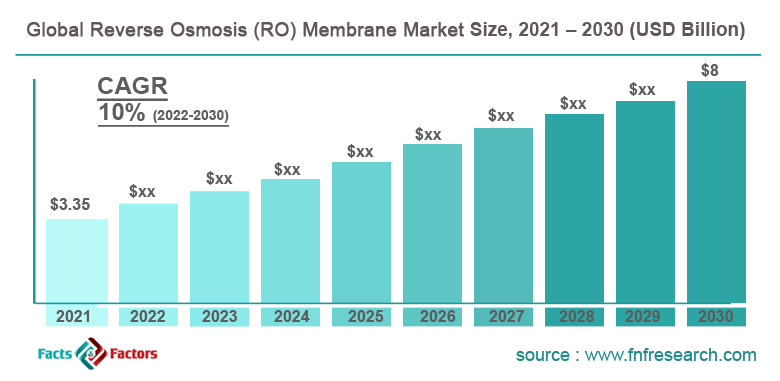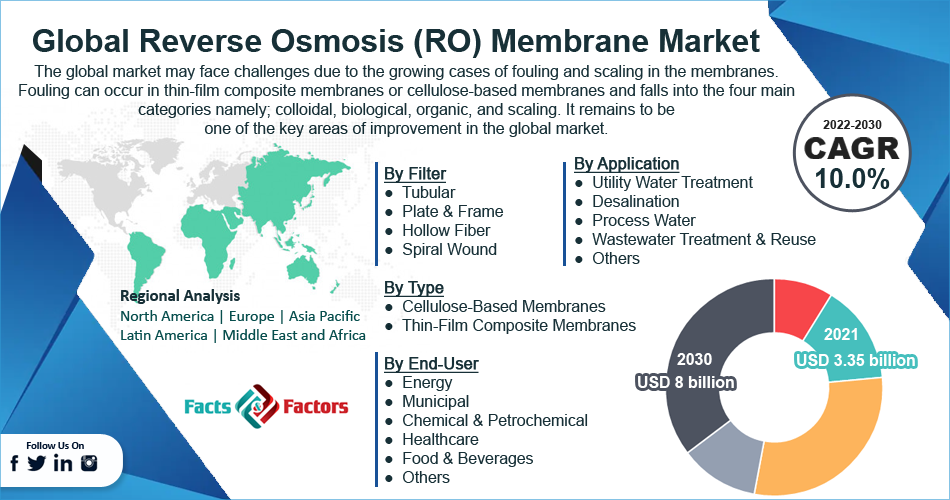Search Market Research Report
Reverse Osmosis (RO) Membrane Market Size, Share Global Analysis Report, 2022 – 2030

Reverse Osmosis (RO) Membrane Market Size, Share, Growth Analysis Report By Filter (Tubular, Plate & Frame, Hollow Fiber, and Spiral Wound), By Type (e), By Application (Utility Water Treatment, Desalination, Process Water, Wastewater Treatment & Reuse, and Others), By End-User (Energy, Municipal, Chemical & Petrochemical, Healthcare, Food & Beverages, and Others), and By Region - Global and Regional Industry Insights, Overview, Comprehensive Analysis, Trends, Statistical Research, Market Intelligence, Historical Data and Forecast 2022 – 2030
Industry Insights
[225+ Pages Report] According to the report published by Facts and Factors, the global reverse osmosis (RO) membrane market size was worth around USD 3.35 billion in 2021 and is predicted to grow to around USD 8 billion by 2030 with a compound annual growth rate (CAGR) of roughly 10% between 2022 and 2030. The report analyzes the global reverse osmosis (RO) membrane market drivers, restraints/challenges, and the effect they have on the demands during the projection period. In addition, the report explores emerging opportunities in the reverse osmosis (RO) membrane market.

 Market Overview
Market Overview
Reverse osmosis is a widely used water treatment process that makes use of a partially permeable membrane to separate unwanted molecules, ions, or larger particles from water, thus effectively treating the water and making it safe for drinking. A partially permeable membrane or a semipermeable membrane is a synthetic or biological membrane made of polymers that will allow the passage of only certain types of ions or molecules through it. It can be seen as a filtering mechanism. The passage rate is dependent on many factors including concentration, pressure, and temperature of the solutes or molecules on either side of the surface where such membranes are used. It is also greatly impacted by the permeability index of the membrane for each solute.
For the membranes used for the reverse osmosis process, the influencing factor is the osmotic pressure which has to be overcome to let the membrane perform effectively. Reverse osmosis (RO) membranes can get rid of all types of suspended particles in the water including chemical and biological species like bacteria. It has found applications in the industrial water treatment process, for the production of mobile or portable eaters, and in residential homes as well.
 Key Insights
Key Insights
- As per the analysis shared by our research analyst, the global reverse osmosis (RO) membrane market is estimated to grow annually at a CAGR of around 10% over the forecast period (2022-2030)
- In terms of revenue, the global reverse osmosis (RO) membrane market size was valued at around USD 3.35 billion in 2021 and is projected to reach USD 8 billion, by 2030.
- The market is projected to grow at a significant rate due to the growing emphasis on industrial water treatment processes
- Based on filter segmentation, the spiral wound was predicted to show maximum market share in the year 2021
- Based on application segmentation, wastewater treatment & reuse is the leading application in 2021
- On the basis of region, North America was the leading revenue generator in 2021

 Growth Drivers
Growth Drivers
- Increasing prioritization of water treatment in industrial areas to drive market growth
The global reverse osmosis (RO) membrane market is projected to grow owing to the rising need and subsequent emphasis on treatment water that is used in industrial settings. In such places, water is used extensively, especially in oil and ore refineries, thermoelectric power plants, hydroelectric dams, and manufacturing plants. These are some examples of industries or factories where water plays the main role in producing the final goods or services.
However, other corporate areas like airports, offices, and railway & bus stations to name a few require a constant supply of water. A single hour without a water supply can lead to undesired situations. Since the water demand is so high, it means that the consumption rate is high. As per estimates, an average of 10 barrels of water is required to produce one barrel of oil. This ratio is proof enough of the amount of water used by the oil industry. The water used remains unfit for further application and if it is let out in other non-contaminated sources of water like nearby seas or lakes, it can potentially pollute the area beyond repair.
 Restraints
Restraints
- Frequent clogging to restrict market expansion
RO membranes act as filters which means that they are highly susceptible to frequent clogging. When RO membranes are clogged, they cannot function effectively and the major impact is on the flow of water which slows down considerably. Hence RO membrane is to be constantly monitored and changed to avoid such errors.
For instance, in residential applications, a typical fully functioning membrane will allow water to fill up in 2 to 3 hrs but in the case of a clogged membrane, the time duration may go up to 4 to 6 hrs. In such cases, RO membranes are recommended to be changed every 2 years.
 Opportunities
Opportunities
- Growing research & development to provide growth opportunities
The global reverse osmosis (RO) market is anticipated to benefit from the increasing research & innovation for the development of new membrane types including material and methods of fabrication. Some of the new materials used to create RO membranes include polyphenylene, aromatic polyamides, hydrated metal oxides, and polybenzimidazole. Defining factors for the use of material to produce membranes are salt and water permeability. Different types of fabrication methods include extending the techniques for the asymmetric membrane to the new materials.
 Challenges
Challenges
- Fouling and scaling factors to challenge the market expansion
The global market may face challenges due to the growing cases of fouling and scaling in the membranes. Fouling can occur in thin-film composite membranes or cellulose-based membranes and falls into the four main categories namely; colloidal, biological, organic, and scaling. It remains to be one of the key areas of improvement in the global market.
 Segmentation Analysis
Segmentation Analysis
The global reverse osmosis (RO) membrane market is segmented based on filter, type, application, end-user, and region.
Based on filter, the global market segments are tubular, plate & frame, hollow fiber, and spiral wound. The global market witnessed the highest growth in the spiral would segment owing to the high effectiveness shown by spiral wound filters. They can be easily cleaned and offer the best value per membrane area. The hollow fiber segment may grow at a CAGR of 9.15%.
Based on application, the global market divisions are utility water treatment, desalination, process water, wastewater treatment & reuse, and others. In 2021, the global market was dominated by the wastewater treatment and reuse segment owing to the growing demand for treating industrial wastewater to make them available for further use.
Wastewater refers to the water generated once it has been used either in a residential or industrial setting. The treatment of such water is the most effective way of avoiding water wastage or water pollution. More than 62 billion gallons of wastewater are treated per day in the United States.
 Recent Developments:
Recent Developments:
- In March 2022, Toray Industries Inc. announced the launch of a new RO membrane element that can work under ultra-low pressure. The company already started the marketing activities in April 2022 and the new product is claimed to successfully reject boron, silica, and other types of neutral molecules in untreated water
- In March 2021, DuPont introduced a new technology to prevent biofouling to encourage the market for reverse osmosis. The technology called DuPont B-Free will reduce operational costs effectively
 Report Scope
Report Scope
Report Attribute |
Details |
Market Size in 2021 |
USD 3.35 Billion |
Projected Market Size in 2030 |
USD 8 Billion |
CAGR Growth Rate |
10% CAGR |
Base Year |
2021 |
Forecast Years |
2022-2030 |
Key Market Players |
LG Chem Ltd., Toray Industries Inc., NX Filtration BV, Membranium (JSC RM Nanotech), Toyobo Co Ltd., Axeon Water Technologies, and others. |
Key Segment |
By Filter, Type, Application, End-User, and Region |
Major Regions Covered |
North America, Europe, Asia Pacific, Latin America, and the Middle East &, Africa |
Purchase Options |
Request customized purchase options to meet your research needs. Explore purchase options |
 Regional Analysis
Regional Analysis
- North America to witness the highest growth during the projection period
The global reverse osmosis (RO) membrane market is projected to witness the highest growth in North America with the US leading with the highest market share. The regional market growth is projected to be driven by the presence of a highly influential and powerful oil industry in the country. The US is claimed to possess the world’s best oil refinery capacity with a production rate of 19 million barrels every day. It is one of the biggest refineries as well. Although the market is currently facing some turmoil due to the rising political situation with the Russian supply of oil, the US is expected to hold its dominance until the end of the decade.
Canada is home to around 17 refineries with most of them producing gasoline. The Saint John refinery located in the New Brunswick province is Canada’s biggest oil refinery with a capacity of 30,00,00 refined barrels per day. As oil remains the most influential factor in terms of global dominance, the US and Canada are expected to invest higher in the oil industry further propelling the global market demand.
 Competitive Analysis
Competitive Analysis
- LG Chem Ltd.
- Toray Industries Inc.
- NX Filtration BV
- Membranium (JSC RM Nanotech)
- Toyobo Co Ltd.
- Axeon Water Technologies
The global reverse osmosis (RO) membrane market is segmented as follows:
 By Filter Segment Analysis
By Filter Segment Analysis
- Tubular
- Plate & Frame
- Hollow Fiber
- Spiral Wound
 By Type Segment Analysis
By Type Segment Analysis
- Cellulose-Based Membranes
- Thin-Film Composite Membranes
 By Application Segment Analysis
By Application Segment Analysis
- Utility Water Treatment
- Desalination
- Process Water
- Wastewater Treatment & Reuse
- Others
 By End-User Segment Analysis
By End-User Segment Analysis
- Energy
- Municipal
- Chemical & Petrochemical
- Healthcare
- Food & Beverages
- Others
 By Regional Segment Analysis
By Regional Segment Analysis
- North America
- The U.S.
- Canada
- Mexico
- Europe
- France
- The UK
- Spain
- Germany
- Italy
- Nordic Countries
- Denmark
- Sweden
- Norway
- Benelux Union
- Belgium
- The Netherlands
- Luxembourg
- Rest of Europe
- Asia Pacific
- China
- Japan
- India
- Australia
- South Korea
- Southeast Asia
- Indonesia
- Thailand
- Malaysia
- Singapore
- Rest of Southeast Asia
- Rest of Asia Pacific
- The Middle East & Africa
- Saudi Arabia
- UAE
- Egypt
- South Africa
- Rest of the Middle East & Africa
- Latin America
- Brazil
- Argentina
- Rest of Latin America
Industry Major Market Players
- LG Chem Ltd.
- Toray Industries Inc.
- NX Filtration BV
- Membranium (JSC RM Nanotech)
- Toyobo Co Ltd.
- Axeon Water Technologies

Copyright © 2025 - 2026, All Rights Reserved, Facts and Factors


